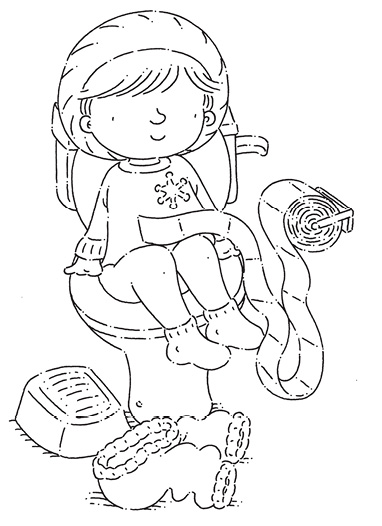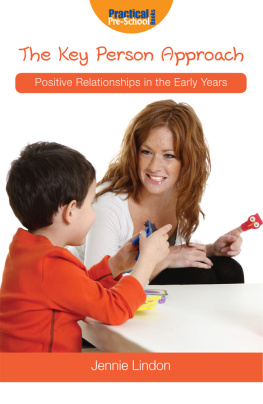Title page
WHAT DOES IT MEAN TO BE TWO?
A practical guide to child development in the Early Years Foundation Stage
Jennie Lindon
Publisher Information
Originally published by Step Forward Publishing Limited
St Judes Church, Dulwich Road, Herne Hill, London, SE24 0PB Tel. 020 7738 5454
2012 digital version by Andrews UK Limited
www.andrewsuk.com
Revised edition Step Forward Publishing Limited 2008
First edition Step Forward Publishing Limited 2006
www.practicalpreschoolbooks.com
All rights reserved. No part of this publication may be reproduced, stored in a retrieval system, or transmitted by any means, electronic, mechanical, photocopied or otherwise, without the prior permission of the publisher.
Focus on two-year-olds
What Does it Mean to be Two? explores the developmental needs and likely skills of two-year-olds. However, it makes sense to show how twos develop within their own personal timeline. So you will also find some examples that include slightly younger children and the content links closely with the other three titles in this series, especially with What Does it Mean to be Three? The approach and ideas of this book are relevant to any practitioner, working with twos anywhere in the UK. The structure of the book, however, follows the framework for England of the Early Years Foundation Stage: guidance covering from birth to five years of age that will be statutory for early years provision from September 2008.
Childrens learning can only be effectively and appropriately supported when adults - practitioners and parents alike - are guided by sound knowledge of child development. The layout of each of the four books in this linked series includes:
- Descriptive developmental information within the main text, organised within the six areas of learning used by the Early Years Foundation Stage.
- For example sections giving instances of real children and real places and sometimes references to useful sources of further examples.
- Being a helpful adult boxes which focus on adult behaviour that is an effective support for childrens learning, as well as approaches that could undermine young children.
- Food for thought headings which highlight points of good practice in ways that can encourage reflection and discussion among practitioners, as well as sharing in partnership with parents.

Where are the twos officially?
Two-year-olds are competent and, for their age, often articulate learners, so as their older selves might announce it is really unfair! that this age group has sometimes been seen as a bit of an oddity from the perspective of early years provision. Young children can end up as two-year-old square pegs jammed into three- or four-year-old round holes. Potential problems arise from the historical split between care and education, which has long troubled good quality experiences for children in early years services across the UK. The problem arises because:
- Nursery schools and classes, playgroups and pre-schools developed to cater for three- to five-year-olds and came to be labelled as early education.
- Daycare settings and childminders accepted children as young as babies and were largely seen as carers.
The care-education division is total nonsense from the childrens perspective. Care or nurture - and learning are inseparable and good early years practice in any kind of provision is always organised around that central understanding.
Unfortunately, official statements and the structure of much inspection have persisted in presenting the two as separate. This approach would matter less if it were separate yet equal, but care and caring are so often treated as the poor relation. If adults undervalue care, that attitude has a negative effect on the quality of provision for three- to five-year-olds. However, a disrespectful only care outlook has even more serious consequences for two-year-olds, because they need demonstrably more caring support.
Up to 2002 any national guidance across the UK was focussed on the over threes. England, Scotland and Wales each had their own early years curriculum document to guide practitioners working with three- to five-year-olds. The framework for Northern Ireland covers three- and four-year-olds, since young children start primary school in the September of the school year after their fourth birthday. Any guidance about good practice with the under threes was developed within a local area by early years teams who were concerned about guiding or enhancing the quality of provision. Then in 2002 the Birth to Three Matters framework was introduced in England and in 2005 Scotland launched their Birth to Three: Supporting our Youngest Children. The most recent changes 2007-8 are that:
- In England from September 2008 the English Birth to Three, and the three to five Foundation Stage, will both be replaced by the birth to five years framework of the Early Years Foundation Stage.
- In Scotland, the current developments for change revolve around a Curriculum for Excellence to cover from three to eighteen years of age. In the earlier years, the main focus for development is for a continuity of more active learning and play from the early education of three to five years olds into the first years of primary school. The Scottish birth to three guidance remains unchanged.
- In Wales, the main focus of development is on the Foundation Phase for young children from three to seven years, bridging the early years curriculum into the first years of primary school. There is no national under threes guidance in Wales.
- In Northern Ireland the early years curriculum applies to three- and four-year-olds, often mainly threes. There is no national under threes guidance and the main focus for current development is the Foundation Stage that applies to the first two years of primary school, with children aged four or five years of age.
The English and Scottish under threes materials had a different appearance and overall structure, but otherwise they had a great deal in common, because the teams drew on the same source materials, including research about very early development.
- Both frameworks place a strong emphasis on the importance of attachment and of close, affectionate relationships for young children. They clearly state that good quality in group care is not possible without
a proper key person system. - Each framework promotes the importance of a home-like atmosphere and emphasises that good practice with under threes is influenced by what usually works well for the children in family life. The consistent message is that under-threes are young children; they are not little pupils. Their environment needs to be a home-like nursery or the actual home of a childminder - not an environment that looks anything like a school classroom. Nurseries are not family homes, but the best group settings have a relaxed, home-like atmosphere - for all the children and not only the youngest.
- Childminders have a head start when it comes to opportunities for a family atmosphere and personal relationships developing within an actual home. The birth to three frameworks, and any local under-threes guidance, all make it clear that childminders should be encouraged to operate in this way. There must be no sense that a drive for quality requires them to turn their homes into mini-nurseries.

Development matters in the Early Years Foundation Stage (EYFS)
Next page




